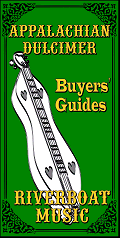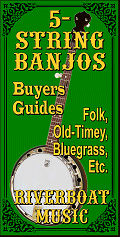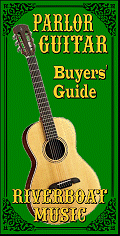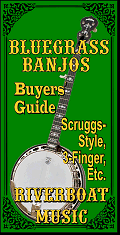Acoustic Instrument
Primers
What Kind of Guitar
Should I Start On?
What Kind of Banjo
Do I Want?
Evaluating and
Buying Used
Guitars
Setting Up
Fretted Instruments Whatever Happened
to the Banjo?
Beginning Five-
String Banjo
6-String Banjos
Banjo Pickups
Axes in my Life
What is a
Bluegrass Banjo?
Dean "Backwoods
Six" Shootout
Music Theory
Primers
Introduction
to Scales
Introduction
to Chords
Circle of Fifths
Other Articles
About Music
How to Give
Guitar Lessons
Musician or
Wannabe? Did God Really
Give Rock &
Roll to You?
Are You a
"Brand Bigot"?
Who Owns Folk Songs?
Historical Links
About the
National Road
The Story Behind
the Story - Real
People, Places,
and Events
About the Play
Play Home
What's New
Overview
About the
Music
About the
History
About the
Logistics
About the
Cast
Synopsis
About the
Set
About the
Author
Contact Us
Home




|

|



Beginning Five-String Folk Banjo - Part Five - Pulling Off and More Melody
| Written by Paul Race for Creek Don't RiseTM and School Of The RockTM |
This is a follow-up to our article on working Melodies into a 5-string picking pattern.
I hope you've been practicing the songs from the previous lessons, both singing and playing. The more sheer time you spend on these foundational exercises, the easier it will be to learn new things.
This lesson will introduce one new technique that is almost as usefull as hammering on, called "Pulling off." Most students find it a little harder than "hammering on," but it serves a similar purpose - sneaking an extra note into the second half of the first beat of your role.
On five-string banjo, playing songs in G, the most common "pull-offs" come on the G chord, "pulling off" from the second fret on the third and fourth string. To practice the former, start with an open chord except for your second finger fretting the third string at the second fret. Pick that note with your right hand.
If you want, once you get used to both of these "pulling off" patterns, you can practice them both by alternating them as in the example below. To hear an mp3 of this pattern click the logo here: Pulling Off

A half of a beat later, pull your finger away from the string in such a way that you're more or less plucking it with your left hand. Then complete your roll. For now, practice playing this pattern on the first and third beat only, playing an open G pattern on beats two and four. No, it doesn't sound as musical as the bits we've done in earlier lessons, but it's very useful once you get the hang of it.

A tab showing this pattern as a part of a roll is shown to the right. To hear an mp3 of this pattern click the logo here: 

Now try the same pattern on the fourth string. 


You will need to learn several other pulling-off patterns, including:
- On the first fret of the second string, when you need to play a C to B transition in a hurry, and
- On the second fret of the first string when you need to play an E to D transition in a hurry. This pattern may require you to hit the first string twice in a row, depending on what else is going on in that measure, but you'll live.
Again, these doesn't sound very musical while you're practicing but you'll find two of them useful in the next song you learn.
"Cripple Creek" Chorus
The most famous banjo song that uses this technique might be "Cripple Creek." We're just going to do the chorus in this lesson, because I need to introduce another technique before we tackle the verse. (By the way, if you try to learn the verse on your own, you should know that there are about fifteen "only authentic ways" to play that. We plan to show you a simple way to play it later on, or you can Google "Cripple Creek Banjo Tab" right now and go directly down the "rabbit hole.")One verson of the melody to the chorus is shown below. To hear an mp3 of just the melody click the logo here: 

You're probably figuring out that creating a banjo part for a song like this revolves chiefly around:
- Working out enough of the melody to make the tune recognizable, then
- Filling in the open parts with as much of your roll as you can fit in.
Our first "whack" at this tune will be as simple as possible to let you focus on the "pulling off" part of the exercise.
You'll notice that there are several places where the melody includes two eighth notes in a row.
- Where the notes are the same, you can sometimes get away with ignoring them, as we do on the very first beat. If that sounds a little dull to you, don't worry, we'll plug something in there soon; we just wanted to let you concentrate on the pulling off part of this exercise. You can also play them by playing the first note on a lower string, fretted up, and the second note on an open string, as we do on the first beat of the second measure.
- Where the notes go up, as on the "Have a little fun" line, you squeeze the second eighth note in by hammering on, something we've been doing for a bit already.
- Where the notes go down, as on the phrase "Cripple Creek," you accomplish that by pulling off from an A to G on the fourth string, as shown in our very first exaple above. You also need to pull off on the line "See my girl." That one requires the B to A pull off, as shown in our last set of chord diagrams above.
Here's the tab for your first version of this. (We'll add some of the Bluegrass licks later. Focus on the "pulling off" bits for now.) To hear an mp3 of this part, cick the logo here: 

You are probably wonder why this doesn't sound quite right. That's because most Bluegrass renditions of this song include a little extra something on the first beat of measures 1, 2,3, 5, 6, and 7. We'll show you how to do it "right" in the next lesson, but for now practice until you can play this song up to speed. Practice singing along with it, too. I don't care if you don't consider yourself a singer; it's an important skill and forces you to practice the rolls until you can do them while you're actually thing about something else, like steering aound a curve and checking your rear view mirror at the same time.
Note About Alternate Melodies - I confess, I learned this song before Bluegrass music became well known outside of the Grand Ol' Opry's circle of influence. While researching how different folks play this tune today, I learned that, according to many of my Bluegrass-picking friends, I've been playing and singing this song "wrong" for about fifty years. I'm too old to change now, of course. Besides it's the way I learned it from several prominent folk singers who learned it before Bluegrass was even invented. But you may wonder why the melody on the eighth measure doesn't seem right. It's because many Bluegrass players today play measure 8 exactly the same way they play measure 4. So if you like doing that yourself, please feel free. It's a folk song, and you're not going to get arrested for singing or playing it any way you want. It's easier than using that B-A pull off anway. As you learn the rest of this song (later), and learn other tunes, you'll learn that there are variations in lots of the melodies. It's up to you to choose the variation you prefer to sing and play, or make up your own. Yes, a handful of nit-pickers will complain that you're not doing it the way one of their idols did it. But there are whiners and haters everywhere; give them all the attention they deserve, which is none at all.
Now Make it Bluegrassy - When you've really got the pulling off parts down, you can add the Bb-B Bluegrass lick in on the first beat of measures 1, 2, 3, 5, 6, and 7. That's not quite how most people play it but it's close enough that you'll fool most people, including most banjo players who can't see your left hand. (Sorry, guys, but it's true.) In the following tab, we've added a Db-D Bluegrass lick on the second beat of measures 2 and 6.
To hear an mp3 of this part, cick the logo here: 
To hear an mp3 of this part played at something closer to "normal speed" for this tune, cick the logo here: 
To hear an mp3 of this part played at something like "normal Bluegrass speed" for this tune, cick the logo here: 

Conclusion
Go back to the songs you learned or tried in Lesson 2 and add the "hammering on" licks we presented in this lesson. Sing along. Don't feel bad if it takes you a while to get used to this. It's 90% learning it so well your hands can do it while you're thinking about something else.In our next lesson, we'll show how these techniques alone will help you play the melody on some classic folk and Bluegrass songs. I'll warn you now, our end game is to get you ready to play a lot of songs we plan to put up eventually, and to read the tabs other folks have already posted.
In the meantime please contact us if you have any questions or hit any brick walls.
All material, illustrations, and content of this web site is copyrighted © 2001, 2002, 2003, 2004, 2005, 2006,
2007, 2008, 2009, 2010, 2011, 2012, 2013, 2014 by Paul D. Race. All rights reserved.
Creek Dont' Rise(tm) is a participant in the Amazon Services LLC Associates Program, an affiliate advertising
program designed to provide a means for sites to earn advertising fees by advertising and linking to Amazon.com.
For questions, comments, suggestions, trouble reports, etc. about this play or about this web page, please contact us.
| Visit related pages and affiliated sites: | ||||||
| - Music - | ||||||

|
 |
 |

|

|

|
|

|

|

|

|

|

|
|
| - Trains and Hobbies - | ||||||
 |

|

|  |
 |

|
|
| - Christmas Memories and Collectibles - | ||||||
 |

|
 |

|
 |

|
|
| - Family Activities and Crafts - | ||||||
 |

|

|

|

|

|
|


